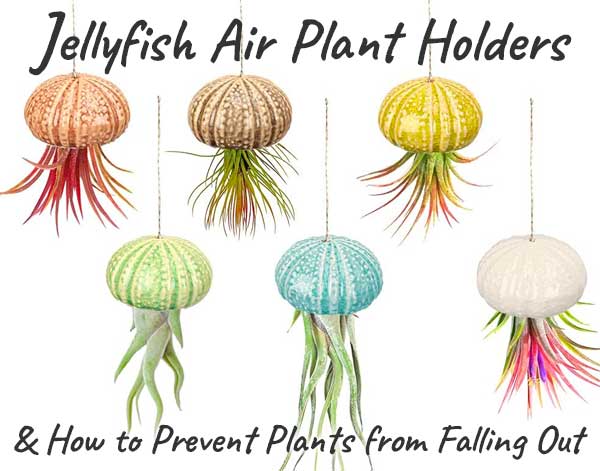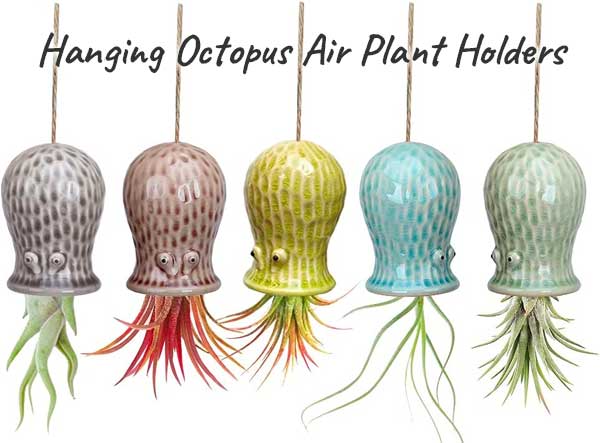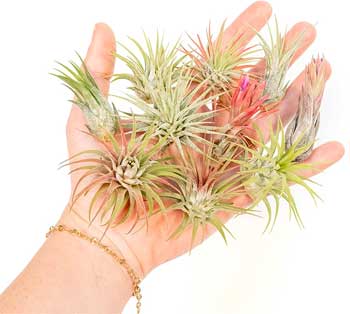Octopus and jellyfish air plant holders can give a bathroom a unique underwater feel with living, low maintenance plants. But how do you hang them, water them and keep them from falling out of their plant holders. Here are the answers…
1. How to Hang a Jellyfish Air Plant Holder
First of all, these ceramic air plant hangers are really easy to attach to your ceiling. They come with hanging cords, so all you’ll need are ceiling hooks, which are cheap. And, of course, air plants.
Just decide where you want to hang your Octopus Tillandsia Planters or Jellyfish Plant Holders and screw the hooks into the ceiling. The mini ceramic pots only weight about 1 lb, so you don’t need to worry about locating a ceiling beam or wall stud.
2. How to Position Tillandsia for Optimal Growth
Keep in mind that air plants thrive best with a few hours of bright indirect sun daily. Therefore, consider placing them next to a window or artificial light source. Mirrors in the room can also help to reflect light. If you notice uneven growth, you can also rotate your Tillandisa every few months.
Tip: Interior decorators and landscapers often use the “Rule of 3” where they create groupings of 3 or 5 for a more natural look. You can do that too, and positioning the planters at varying elevations can look more organic as well. Also see more air plant decorating ideas.

3. How to Care for Tillansdia Air Plants
Many people are drawn to air plants because they don’t require lots of care. In fact, they don’t even need soil. Instead of absorbing nutrients through their roots, they get them via their leaves – making them ideal for moisture-rich humid bathrooms.
That said, you want to mist them every few days with water. Alternatively, you can remove them from their planters and soak them in water once a week for 30 minutes. Make sure to shake off any excess water before placing them back in the holder.
4. Should You Fertilize Your Air Plants?
Some people also fertilize their air plants once a month with a bromeliad fertilizer specifically designed for air plants. You can get this plant food as a pre-mixed spray, so it’s just as easy as your regular watering.

Fertilizing is not a requirement. However, if you’re wondering whether or not you want to use it, here are some of the benefits:
- Fertilizers provide essential nutrients, like nitrogen, phosphorus and potassium, that air plants need to grow and thrive. These nutrients don’t float around in the air, nor are they likely in the water you’re spraying on them.
- Plant food can help promote growth and reproduction of air plants. Not to mention, they will produce more vibrant flowers.
- The added nutrients make air plants healthier, thus making them more resistant to diseases and pests. In addition, plants can heal faster if they are sick or damaged.
5. How to Revive a Dying Air Plant
- Remove your your air plant from its container and soak it in water for about 20-30 minutes. Continue to mist regularly and possibly use fertilizer.
- Relocate your plant to a sunnier, brighter spot.
- Increase the air circulation by using a fan or opening a window. Tillandsia like good air flow.
Tip: If you notice that your Tillandsia starts turning brown or looking dry, it most likely needs more water. Increase your watering , or it may be a sign that you need to take more showers.
6. How to Prevent Air Plants from Falling Out of the Jellyfish Holders
With an upside-down planter, people often wonder what keeps the plants from falling out? Basically, you want them to fit snugly in the planter. In addition, you can use a bit of floral wire or fishing line to secure the plants in place. Moss can also help hold the plants in place.
How to Choose the Right Size Air Plants:
Air plants come in different sizes, so it’s important to choose a plant that fits comfortably in your holder.
For small holders (like the jellyfish and octopus planters above), choose smaller air plants such as Tillandsia ionantha or Tillandsia stricta. For larger holders, choose larger air plants such as Tillandsia xerographica or Tillandsia capitata.




